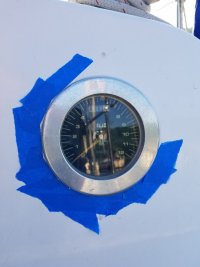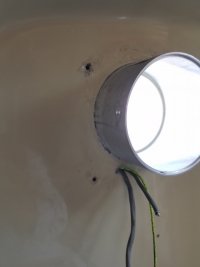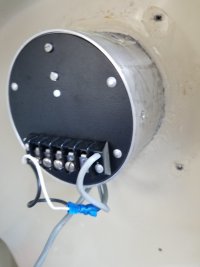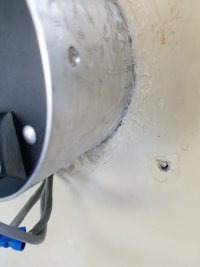klb67pgh
Member III
My E25 has a period Electro Marine Systems knot meter and log, but no transducers. I want to remove it and install a Raymarine ST60 tridata that I picked up lightly used. I discovered 2 screws in the side of the housing that enabled me to remove the knot meter from the rear of the housing. What is left is a metal housing w a glass lense that is now more or less a tiny portlight.
I tried a razor blade between the outer metal flange and the outside bulkhead. I couldn't get the blade in very far. I tried a dead blow hammer on the inside edge of the metal housing. I did not detect movement. I used a heat gun and was able to loosen some of the clear adhesive, even some alongside the housing and the inner bulkhead. I tried hitting a wooden wedge (half a clothespin) between the side of the housing against the back of the outside flange. No movement.
More heat is my next step, but a storm cut short my work session. Assuming that doesn't work, I plan to go back to a brand new razor blade. But I'm looking for other ideas, especially if someone has successfully removed such a housing. The adhesive feels like silicone, but it may be something else w more adhesive capabilities.
I really don't want to make the bulkhead hole any bigger, as I might be able to get away w the existing housing w the ST60 and not add a blank out plate.
Thanks for any suggestions you can offer.
Kevin
I tried a razor blade between the outer metal flange and the outside bulkhead. I couldn't get the blade in very far. I tried a dead blow hammer on the inside edge of the metal housing. I did not detect movement. I used a heat gun and was able to loosen some of the clear adhesive, even some alongside the housing and the inner bulkhead. I tried hitting a wooden wedge (half a clothespin) between the side of the housing against the back of the outside flange. No movement.
More heat is my next step, but a storm cut short my work session. Assuming that doesn't work, I plan to go back to a brand new razor blade. But I'm looking for other ideas, especially if someone has successfully removed such a housing. The adhesive feels like silicone, but it may be something else w more adhesive capabilities.
I really don't want to make the bulkhead hole any bigger, as I might be able to get away w the existing housing w the ST60 and not add a blank out plate.
Thanks for any suggestions you can offer.
Kevin
Attachments
Last edited:





